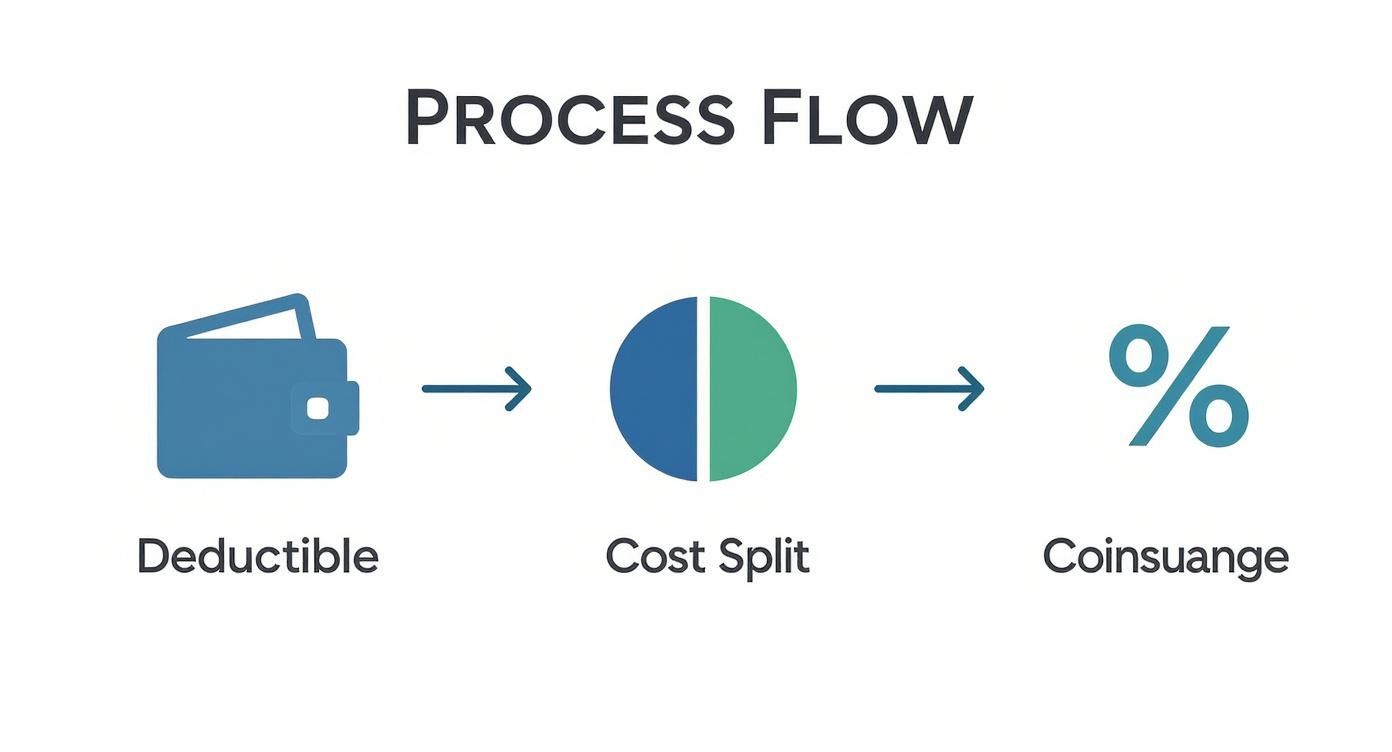So, you’ve hit your health insurance deductible for the year. What happens next? This is where coinsurance comes into play.
Think of it as a team effort between you and your insurance company. After you've paid your deductible, your insurer starts picking up most of the tab for your medical bills. But you're still responsible for a small piece of it—that's your coinsurance. It's always a percentage of the total bill, not a flat fee.
Decoding Your Share of the Bill
This cost-sharing system is one of the most fundamental parts of any health insurance plan. Once your deductible is out of the way, you and your insurer work together to cover the rest of your healthcare costs for the year.
The most common arrangement you'll see is an 80/20 split. Here’s what that looks like in the real world:
- Your Insurer Pays: They cover the bigger chunk—in this case, 80% of the approved medical bill.
- You Pay: You handle the smaller portion, which is the remaining 20% of the bill.
You'll continue paying your percentage until you reach your plan's out-of-pocket maximum. While the exact numbers might change from plan to plan (some are 90/10 or 70/30), the idea is always the same. Your insurance carrier takes on the lion's share, and you pay a predictable slice.
Coinsurance at a Glance
To make it even clearer, here's a quick breakdown of what you need to know.
| Key Term | Simple Explanation |
|---|---|
| Coinsurance | The percentage of medical costs you pay after your deductible is met. |
| Deductible | The amount you must pay out-of-pocket before coinsurance kicks in. |
| 80/20 Split | A common example where the insurer pays 80% and you pay 20%. |
| Out-of-Pocket Max | The absolute most you'll pay for covered services in a year. |
Getting a grip on these terms is the first step to truly understanding your health coverage. For a broader look at insurance language, this general insurance glossary is a great resource.
And if you want to dive even deeper into health-specific terms, our own health insurance glossary has you covered.
How Your Health Plan Costs Work Together
Figuring out your health plan’s costs can feel like trying to solve a puzzle. Each piece—premium, deductible, coinsurance—fits together in a specific order. Once you understand that order, you can see the full picture of what you’ll actually owe.
It all starts with your premium. Think of this as your monthly membership fee. You pay it just to keep your plan active, whether you see a doctor or not. It's what keeps the lights on, but it doesn't cover the cost of care itself. That's where the next steps come in.
The Payment Path From Deductible to Coinsurance
The first big step in paying for care is your deductible. This is the amount you have to pay out-of-pocket for your medical services each year before your insurance company starts to chip in. For a closer look at how this works, you can learn more about what a deductible in insurance is.
Once you’ve paid that full amount, you've officially met your deductible. Congratulations! Now, your coinsurance kicks in, and this is where you and your insurer become partners in paying the bills. If your plan has 20% coinsurance, you'll start paying just 20% of your medical costs, and your insurance will handle the other 80%.
This infographic breaks down that transition from shouldering the full cost to sharing it.

As you can see, your responsibility shifts from paying 100% of the bills (to meet the deductible) to a much smaller, more manageable percentage (your coinsurance).
Reaching the Financial Finish Line
You'll keep sharing costs with your insurer until you hit one final, very important number.
Your out-of-pocket maximum is the absolute most you will have to pay for covered services in a plan year. Once you reach this limit through a combination of your deductible, copayments, and coinsurance payments, your insurance company pays 100% of covered costs for the rest of the year.
This is your financial safety net. It’s designed to protect you from catastrophic costs if you face a serious health issue. Knowing this number gives you peace of mind, because it tells you the absolute worst-case scenario for your medical spending in any given year.
A Real-World Coinsurance Calculation
Theory is one thing, but seeing how the numbers play out with a real medical bill? That’s when it all clicks. Let’s walk through a common scenario to show you exactly what coinsurance means for your wallet.

Imagine you have a hospital procedure that leaves you with a $10,000 bill. Scary, right? But you have insurance. Here are your plan’s key details:
- Deductible: $3,000
- Coinsurance: 20% (this is often called an 80/20 split)
- Out-of-Pocket Maximum: $7,000
So, how much of that $10,000 are you actually responsible for? Let's break it down. It’s a lot simpler than it looks.
Step 1: Hit Your Deductible First
Before your insurance company starts chipping in, you have to cover your deductible. Think of it as the first hurdle.
You’re on the hook for 100% of your medical costs until you’ve paid $3,000. So, you pay that first, which leaves a $7,000 balance on the bill.
Step 2: Now, Coinsurance Kicks In
Once your deductible is met, you’re no longer paying alone. This is where the cost-sharing begins.
Your plan has a 20% coinsurance. That means you pay 20% of the remaining $7,000. A quick calculation shows your share is $1,400. Your insurance company finally steps in and covers the other 80%, which is $5,600.
Step 3: Add It All Up
To figure out your total cost for this single procedure, you just add what you paid for the deductible to your coinsurance share. It's a simple two-part equation.
Your Total Payment = Deductible + Coinsurance Share
$4,400 = $3,000 + $1,400
Here’s a table that lays it all out clearly.
Cost Breakdown for a $10,000 Medical Bill
This table shows exactly who pays what and when.
| Expense Component | Amount You Pay | Amount Insurance Pays |
|---|---|---|
| Initial Bill | $10,000 | $0 |
| Your Deductible | $3,000 | $0 |
| Remaining Balance | $7,000 | (Shared Cost) |
| Your Coinsurance (20% of $7k) | $1,400 | $5,600 |
| Total You Paid | $4,400 | $5,600 |
So, for that overwhelming $10,000 bill, your final responsibility is $4,400.
Because your total payment is less than your $7,000 out-of-pocket maximum, you haven't hit your plan's financial safety net for the year just yet. But as you can see, this process demystifies how costs are shared and shows exactly how your plan protects you from paying the full, staggering amount.
Coinsurance vs. Copay vs. Deductible
Trying to understand your health insurance policy can feel like you’re learning a whole new language. When you get down to the money part—what you actually have to pay—three terms pop up again and again: deductible, copay, and coinsurance.
Getting these straight is the key to knowing exactly what your care will cost you. They all work together, but each one has a very specific job.

Let's imagine your health plan is a members-only coffee shop for the year. Your deductible is the annual membership fee you pay upfront. Before the coffee shop starts giving you any member discounts, you have to pay this fee out of your own pocket. Until you've met it, you're on the hook for 100% of your medical bills.
A copay is simpler. It's a flat fee you pay for certain services, like a doctor’s appointment or prescription. Think of it as paying a set price of $3 for a standard black coffee every time you visit, no matter what it actually costs the shop to make. You usually pay this fixed amount whether you've met your deductible or not, which makes costs for routine care nice and predictable.
How Coinsurance Is Different
So, where does coinsurance fit in? Unlike the flat fee of a copay, coinsurance is a percentage of the total bill.
Back at our coffee shop, this is like ordering a fancy, custom latte. After you've paid your annual membership fee (your deductible), the shop agrees to cover most of the cost, but you still have to chip in for 20% of the price of that special drink. This means what you pay changes based on how expensive the service is. A simple check-up will cost you less than a major surgery.
Here's a quick rundown to keep them straight:
- Deductible: The amount you must pay before your insurance starts chipping in.
- Copay: A fixed, predictable dollar amount you pay for a specific service.
- Coinsurance: The percentage of your medical costs you pay after you've met your deductible.
Copays have long been a staple of health insurance plans. In fact, data from 2012 showed that 66.3% of employees with employer-sponsored coverage had plans featuring copays for routine care. You can discover more insights about these health plan trends in the full report. For a deeper dive, check out our guide on the differences between coinsurance and copays.
The key takeaway is simple: Deductibles come first. Once you've paid that off, coinsurance kicks in as a percentage of your bills. Copays are different—they're fixed fees for specific services that can apply anytime, depending on your plan's rules.
How Coinsurance Shapes Your Health Plan Choice
Picking a health plan can feel like a bit of a gamble. Do you pay more every month to protect yourself from future "what-ifs," or do you save on monthly costs and hope for the best? This is the classic trade-off between your premium and your coinsurance, and it’s at the heart of finding the right fit.
Let’s talk about those plans with tempting low monthly premiums. They keep your fixed costs down, which feels great on your budget. The catch? They usually come with a higher coinsurance rate—think 30% or even 40%. This means that once you meet your deductible, you’re still on the hook for a pretty big chunk of the bill. You can discover more insights about coinsurance explained on getinsured.com.
This kind of plan can be a perfectly smart move if you're generally healthy and don’t see a doctor often. You save money month after month, but you're accepting more financial risk if a serious health issue pops up unexpectedly.
Finding Your Ideal Coinsurance Balance
On the flip side, you have plans with higher monthly premiums. The sticker shock might be a little more intense, but these plans typically offer a much lower coinsurance percentage, like 10% or 20%.
Once your deductible is met, your insurance company steps in to cover a much larger share of the costs. This creates a stronger financial safety net and makes your out-of-pocket expenses for care far more predictable. For families who expect regular check-ups or anyone managing a chronic condition, this predictability is invaluable.
The right choice isn't about which plan is "better"—it's about which plan is better for you. It all comes down to balancing your monthly budget with your health needs and how comfortable you are with financial risk.
Making this decision is a huge part of building a healthcare strategy that actually works for your life. For a deeper dive, check out our guide on how to choose the right health insurance for your specific situation.
Your Coinsurance Questions, Answered
Even after you get the basics down, coinsurance can still feel a little tricky in the real world. Think of this as your quick-and-easy FAQ for those practical questions that always seem to come up.
Let's clear up any confusion so you can feel confident about how your plan works.
Do I Pay Coinsurance on Every Single Medical Bill?
Nope. Coinsurance only kicks in after you have met your annual deductible. Until that happens, you’re usually on the hook for 100% of your medical bills. Coinsurance is the next phase, where you and your insurer start sharing the costs.
Think of it like a two-part race. Your deductible is the first leg, and you have to run it solo. Once you cross that finish line, your insurer joins you for the rest of the race, covering the lion's share of the costs.
So, Is Coinsurance Paid Before or After My Deductible?
It’s always paid after your deductible is met. This is a super important detail to remember. For any major medical expense, the payment order almost always looks like this:
- You pay 100% of costs until you hit your deductible.
- Then, you pay your coinsurance percentage (like 20%) on the bills that follow.
- This continues until you reach your out-of-pocket maximum for the year.
Once you hit that max, your insurance company takes over and covers 100% of all eligible, in-network medical care for the rest of the year. You've done your part.
Does My Coinsurance Payment Count Toward My Out-of-Pocket Max?
Yes, it absolutely does. This is one of the most important things your out-of-pocket maximum does—it acts as your ultimate financial safety net for the year.
Every dollar you pay for your deductible, copays, and coinsurance gets tallied up. It all counts toward hitting your out-of-pocket maximum, putting a firm limit on how much you’ll spend on healthcare in a year.
Once you reach that limit, you can breathe a little easier knowing your insurer is handling the rest of the covered bills for that plan year.
Can Coinsurance Rates Be Different for Different Services?
Usually, your plan has one main coinsurance rate that applies to most in-network care once your deductible is paid. For example, if you have 20% coinsurance, that same 20% will likely apply to a specialist visit, lab work, or a hospital stay.
However, it’s always smart to double-check your plan’s official documents (the Summary of Benefits and Coverage is great for this). Some plans might have different coinsurance rates for specific things, like prescription drugs or out-of-network care, which often comes with a much higher cost-sharing percentage.
Knowing these details helps you see costs coming and make smarter choices about your care. If you're looking for a plan that truly fits your life, My Policy Quote can help you compare your options and find the right coverage. Explore your health insurance choices at https://mypolicyquote.com.


